
Hermit crabs are anomuran decapod crustaceans of the superfamily Paguroidea that have adapted to occupy empty scavenged mollusc shells to protect their fragile exoskeletons. There are over 800 species of hermit crab, most of which possess an asymmetric abdomen concealed by a snug-fitting shell. Hermit crabs' soft (non-calcified) abdominal exoskeleton means they must occupy shelter produced by other organisms or risk being defenseless.

Pagurus pollicaris is a hermit crab commonly found along the Atlantic coast of North America from New Brunswick to the Gulf of Mexico. It is known by a number of common names, including gray hermit crab, flat-clawed hermit crab, flatclaw hermit crab, shield hermit crab, thumb-clawed hermit crab, broad-clawed hermit crab, and warty hermit crab.

Cancer pagurus, commonly known as the edible crab or brown crab, is a species of crab found in the North Sea, North Atlantic Ocean, and perhaps the Mediterranean Sea. It is a robust crab of a reddish-brown colour, having an oval carapace with a characteristic "pie crust" edge and black tips to the claws. A mature adult may have a carapace width up to 25 centimetres and weigh up to 3 kilograms. C. pagurus is a nocturnal predator, targeting a range of molluscs and crustaceans. It is the subject of the largest crab fishery in Western Europe, centred on the coasts of the Ireland and Britain, with more than 60,000 tonnes caught annually.
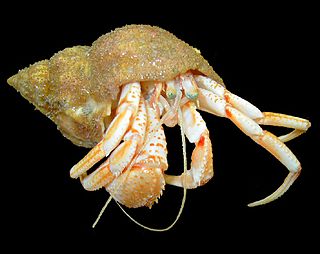
Pagurus bernhardus is the common marine hermit crab of Europe's Atlantic coasts. It is sometimes referred to as the common hermit crab or soldier crab. Its carapace reaches 3.5 centimetres (1.4 in) long, and is found in both rocky and sandy areas, from the Arctic waters of Iceland, Svalbard and Russia as far south as southern Portugal, but its range does not extend as far as the Mediterranean Sea. It can be found in pools on the upper shore and at the mean tide level down to a depth of approximately 140 metres (460 ft), with smaller specimens generally found in rock pools around the middle shore and lower shore regions, with larger individuals at depth. P. bernhardus is an omnivorous detritivore that opportunistically scavenges for carrion, and which can also filter feed when necessary.
The Plain brush-tailed rat is a spiny rat species found in Brazil.

Pagurus longicarpus, the long-wristed hermit crab, is a common hermit crab found along the Atlantic and Gulf coasts of the United States and the Atlantic coast of Canada.
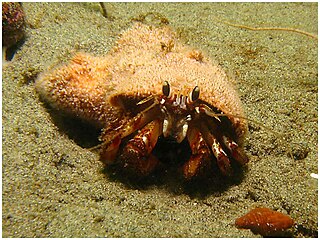
Pagurus is a genus of hermit crabs in the family Paguridae. Like other hermit crabs, their abdomen is not calcified and they use snail shells as protection. These marine decapod crustaceans are omnivorous, but mostly prey on small animals and scavenge carrion. Trigonocheirus and Pagurixus used to be considered subgenera of Pagurus, but the former is nowadays included in Orthopagurus, while the latter has been separated as a distinct genus.

Crab meat or crab marrow is the meat found within a crab, or more specifically in the leg of a crab. It is used in many cuisines around the world for its soft, delicate and sweet flavor. Crab meat is low in fat and provides approximately 340 kilojoules (82 kcal) of food energy per 85-gram (3 oz) serving. Brown crab, blue crabs, blue swimming crabs, and red swimming crabs are among the most commercially available species of crabmeat globally.

Pagurus hirsutiusculus is a species of hermit crab, commonly called the hairy hermit crab. It lives from the Bering Strait south to California and Japan, from the intertidal zone to a depth of 110 m (360 ft).

Crab fisheries are fisheries which capture or farm crabs. True crabs make up 20% of all crustaceans caught and farmed worldwide, with about 1.4 million tonnes being consumed annually. The horse crab, Portunus trituberculatus, accounts for one quarter of that total. Other important species include flower crabs, snow crabs (Chionoecetes), blue crabs, edible or brown crabs, Dungeness crab, and mud crabs, each of which provides more than 20,000 tonnes annually.

Pagurus armatus, the armed hermit crab or black-eyed hermit crab, is a species of hermit crab found in the eastern Pacific Ocean of the United States and British Columbia, Canada.
Profundiconus ikedai is a species of sea snail, a marine gastropod mollusk in the family Conidae, the cone snails and their allies.

Pagurus sinuatus is a large species of hermit crab found in Australia and the Kermadec Islands. It is red or orange in colour with coloured bands on the legs and patches on the body.
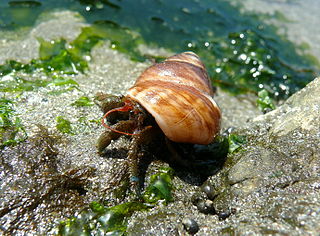
Pagurus samuelis, the blueband hermit crab, is a species of hermit crab from the west coast of North America, and the most common hermit crab in California. It is a small species, with distinctive blue bands on its legs. It prefers to live in the shell of the black turban snail, and is a nocturnal scavenger of algae and carrion.

Deramas ikedai is a butterfly of the family Lycaenidae, found on Mindanao in the Philippines. The species was first described by Hisakazu Hayashi in 1978.
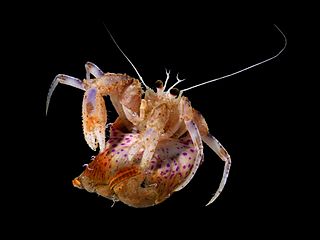
Pagurus prideaux is a species of hermit crab in the family Paguridae. It is found in shallow waters off the northwest coast of Europe and usually lives symbiotically with the sea anemone Adamsia palliata.
Acrossocheilus ikedai is a species of ray-finned fish in the genus Acrossocheilus. It is endemic to China, where it inhabits the Yangtze river system in Hainan. It has a maximum length of about 10.7 cm (4.2 in).
Pagurus forbesii is a species of hermit crab in the family Paguridae. It is found in the northeastern Atlantic Ocean and the Mediterranean Sea.
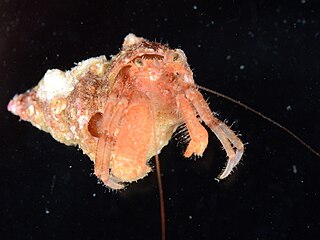
Pagurus dalli, commonly known as the whiteknee hermit or whiteknee hermit crab, is a species of hermit crab in the family Paguridae. It is found in the northeastern Pacific Ocean at depths down to about 276 m (900 ft). It usually lives in a mutualistic symbiosis with a sponge, or sometimes a hydroid.

Clistosaccus is a genus of barnacles which are parasitic on hermit crabs. It is a monotypic genus, and the single species is Clistosaccus paguri, which is found in the northern Atlantic Ocean and the northern Pacific Ocean.
















